A Critical Analysis of the Bitcoin White Paper and Cryptoeconomics
VerifiedAdded on 2023/01/11
|7
|1269
|71
Report
AI Summary
This report presents a critical analysis of the Bitcoin white paper, focusing on the underlying economic problem of transferring money electronically without a third party, which often involves extra costs and trust issues. The paper proposes a peer-to-peer electronic cash system using blockchain technology to solve the double-spending problem through a timestamp server and proof-of-work mechanism. The analysis further delves into the concept of institutional cryptoeconomics, highlighting its impact on economic activities, cost savings, and market incentives. It also discusses the potential disruptions to traditional financial intermediaries and the need for new regulations to manage and govern cryptoeconomics. The report concludes that Bitcoin's system offers significant benefits in terms of security, transparency, and the removal of third parties, despite some remaining challenges.
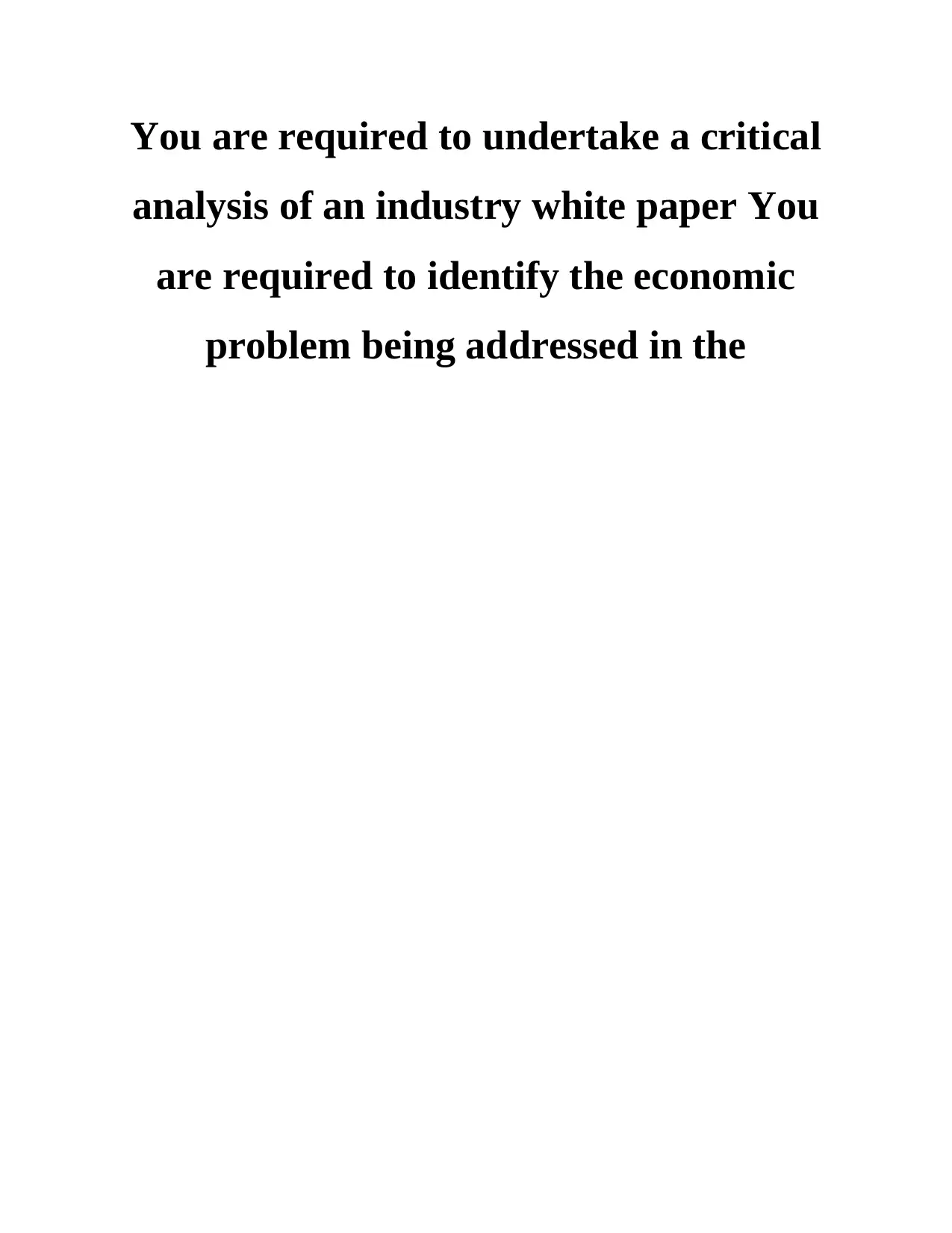
You are required to undertake a critical
analysis of an industry white paper You
are required to identify the economic
problem being addressed in the
analysis of an industry white paper You
are required to identify the economic
problem being addressed in the
Paraphrase This Document
Need a fresh take? Get an instant paraphrase of this document with our AI Paraphraser

Executive Summary
Bitcoin a peer to peer electronic cash system which is based on blockchain and cyptocurrency
has been discussed in the report. This enhance quality of financial exchange and also removes
the limitation of existing financial transfers through economic platforms.
Bitcoin a peer to peer electronic cash system which is based on blockchain and cyptocurrency
has been discussed in the report. This enhance quality of financial exchange and also removes
the limitation of existing financial transfers through economic platforms.

Table of Contents
INTRODUCTION...........................................................................................................................4
MAIN BODY..................................................................................................................................4
Underlying Economic Problem...................................................................................................4
Analysis of White Paper..............................................................................................................4
Understanding of Institutional Cryptoeconomics........................................................................5
CONCLUSION................................................................................................................................6
REFERENCES................................................................................................................................7
INTRODUCTION...........................................................................................................................4
MAIN BODY..................................................................................................................................4
Underlying Economic Problem...................................................................................................4
Analysis of White Paper..............................................................................................................4
Understanding of Institutional Cryptoeconomics........................................................................5
CONCLUSION................................................................................................................................6
REFERENCES................................................................................................................................7
⊘ This is a preview!⊘
Do you want full access?
Subscribe today to unlock all pages.

Trusted by 1+ million students worldwide
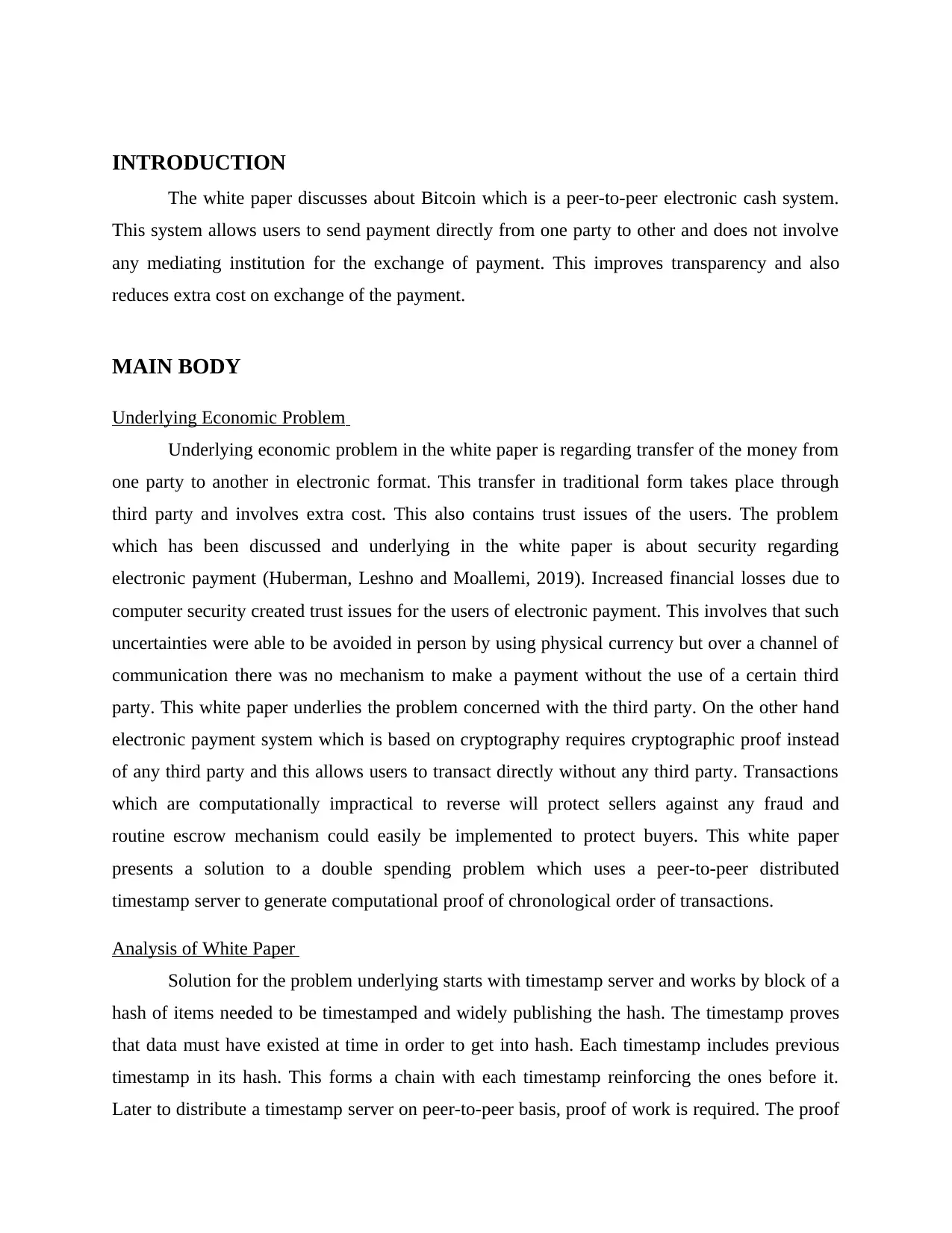
INTRODUCTION
The white paper discusses about Bitcoin which is a peer-to-peer electronic cash system.
This system allows users to send payment directly from one party to other and does not involve
any mediating institution for the exchange of payment. This improves transparency and also
reduces extra cost on exchange of the payment.
MAIN BODY
Underlying Economic Problem
Underlying economic problem in the white paper is regarding transfer of the money from
one party to another in electronic format. This transfer in traditional form takes place through
third party and involves extra cost. This also contains trust issues of the users. The problem
which has been discussed and underlying in the white paper is about security regarding
electronic payment (Huberman, Leshno and Moallemi, 2019). Increased financial losses due to
computer security created trust issues for the users of electronic payment. This involves that such
uncertainties were able to be avoided in person by using physical currency but over a channel of
communication there was no mechanism to make a payment without the use of a certain third
party. This white paper underlies the problem concerned with the third party. On the other hand
electronic payment system which is based on cryptography requires cryptographic proof instead
of any third party and this allows users to transact directly without any third party. Transactions
which are computationally impractical to reverse will protect sellers against any fraud and
routine escrow mechanism could easily be implemented to protect buyers. This white paper
presents a solution to a double spending problem which uses a peer-to-peer distributed
timestamp server to generate computational proof of chronological order of transactions.
Analysis of White Paper
Solution for the problem underlying starts with timestamp server and works by block of a
hash of items needed to be timestamped and widely publishing the hash. The timestamp proves
that data must have existed at time in order to get into hash. Each timestamp includes previous
timestamp in its hash. This forms a chain with each timestamp reinforcing the ones before it.
Later to distribute a timestamp server on peer-to-peer basis, proof of work is required. The proof
The white paper discusses about Bitcoin which is a peer-to-peer electronic cash system.
This system allows users to send payment directly from one party to other and does not involve
any mediating institution for the exchange of payment. This improves transparency and also
reduces extra cost on exchange of the payment.
MAIN BODY
Underlying Economic Problem
Underlying economic problem in the white paper is regarding transfer of the money from
one party to another in electronic format. This transfer in traditional form takes place through
third party and involves extra cost. This also contains trust issues of the users. The problem
which has been discussed and underlying in the white paper is about security regarding
electronic payment (Huberman, Leshno and Moallemi, 2019). Increased financial losses due to
computer security created trust issues for the users of electronic payment. This involves that such
uncertainties were able to be avoided in person by using physical currency but over a channel of
communication there was no mechanism to make a payment without the use of a certain third
party. This white paper underlies the problem concerned with the third party. On the other hand
electronic payment system which is based on cryptography requires cryptographic proof instead
of any third party and this allows users to transact directly without any third party. Transactions
which are computationally impractical to reverse will protect sellers against any fraud and
routine escrow mechanism could easily be implemented to protect buyers. This white paper
presents a solution to a double spending problem which uses a peer-to-peer distributed
timestamp server to generate computational proof of chronological order of transactions.
Analysis of White Paper
Solution for the problem underlying starts with timestamp server and works by block of a
hash of items needed to be timestamped and widely publishing the hash. The timestamp proves
that data must have existed at time in order to get into hash. Each timestamp includes previous
timestamp in its hash. This forms a chain with each timestamp reinforcing the ones before it.
Later to distribute a timestamp server on peer-to-peer basis, proof of work is required. The proof
Paraphrase This Document
Need a fresh take? Get an instant paraphrase of this document with our AI Paraphraser
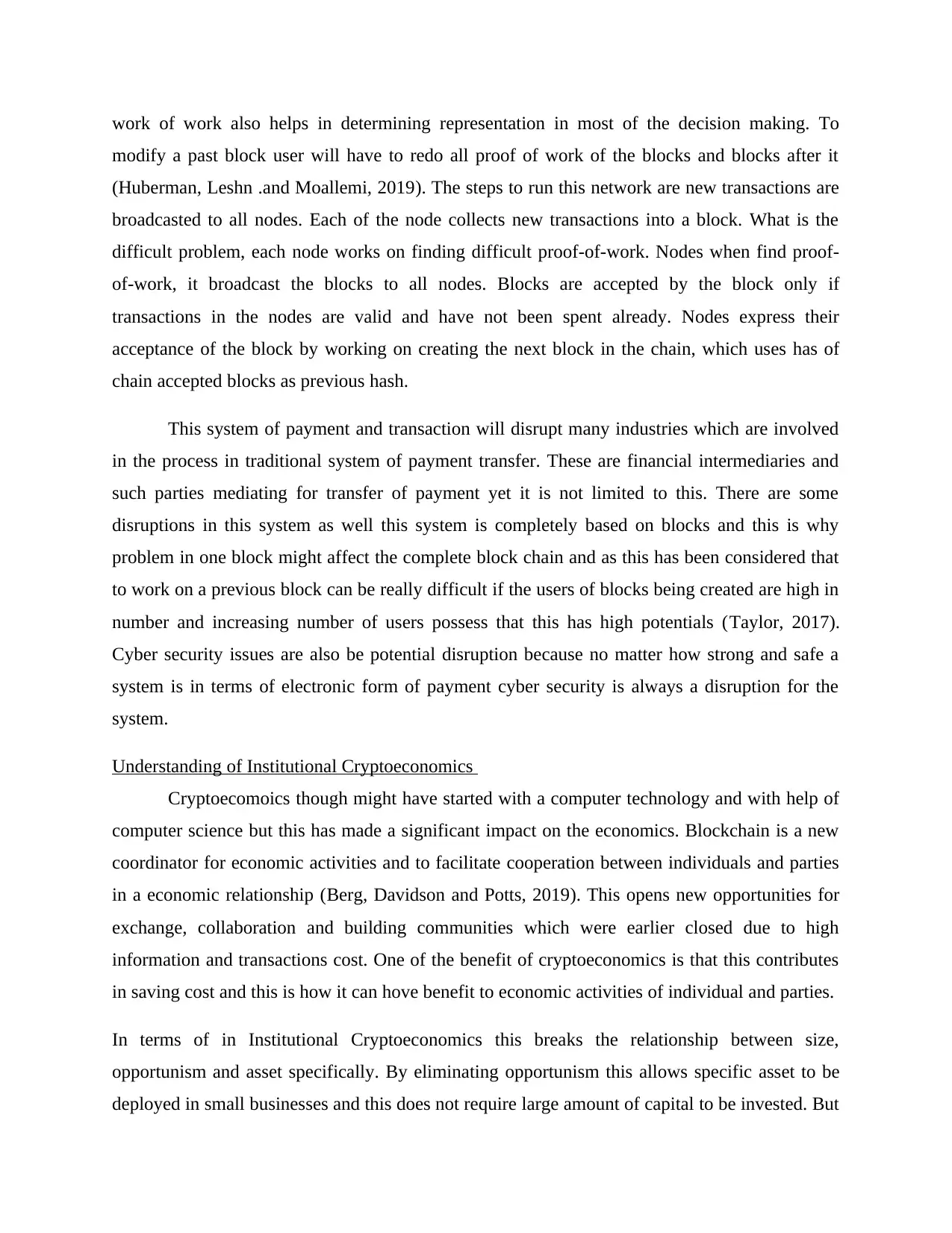
work of work also helps in determining representation in most of the decision making. To
modify a past block user will have to redo all proof of work of the blocks and blocks after it
(Huberman, Leshn .and Moallemi, 2019). The steps to run this network are new transactions are
broadcasted to all nodes. Each of the node collects new transactions into a block. What is the
difficult problem, each node works on finding difficult proof-of-work. Nodes when find proof-
of-work, it broadcast the blocks to all nodes. Blocks are accepted by the block only if
transactions in the nodes are valid and have not been spent already. Nodes express their
acceptance of the block by working on creating the next block in the chain, which uses has of
chain accepted blocks as previous hash.
This system of payment and transaction will disrupt many industries which are involved
in the process in traditional system of payment transfer. These are financial intermediaries and
such parties mediating for transfer of payment yet it is not limited to this. There are some
disruptions in this system as well this system is completely based on blocks and this is why
problem in one block might affect the complete block chain and as this has been considered that
to work on a previous block can be really difficult if the users of blocks being created are high in
number and increasing number of users possess that this has high potentials (Taylor, 2017).
Cyber security issues are also be potential disruption because no matter how strong and safe a
system is in terms of electronic form of payment cyber security is always a disruption for the
system.
Understanding of Institutional Cryptoeconomics
Cryptoecomoics though might have started with a computer technology and with help of
computer science but this has made a significant impact on the economics. Blockchain is a new
coordinator for economic activities and to facilitate cooperation between individuals and parties
in a economic relationship (Berg, Davidson and Potts, 2019). This opens new opportunities for
exchange, collaboration and building communities which were earlier closed due to high
information and transactions cost. One of the benefit of cryptoeconomics is that this contributes
in saving cost and this is how it can hove benefit to economic activities of individual and parties.
In terms of in Institutional Cryptoeconomics this breaks the relationship between size,
opportunism and asset specifically. By eliminating opportunism this allows specific asset to be
deployed in small businesses and this does not require large amount of capital to be invested. But
modify a past block user will have to redo all proof of work of the blocks and blocks after it
(Huberman, Leshn .and Moallemi, 2019). The steps to run this network are new transactions are
broadcasted to all nodes. Each of the node collects new transactions into a block. What is the
difficult problem, each node works on finding difficult proof-of-work. Nodes when find proof-
of-work, it broadcast the blocks to all nodes. Blocks are accepted by the block only if
transactions in the nodes are valid and have not been spent already. Nodes express their
acceptance of the block by working on creating the next block in the chain, which uses has of
chain accepted blocks as previous hash.
This system of payment and transaction will disrupt many industries which are involved
in the process in traditional system of payment transfer. These are financial intermediaries and
such parties mediating for transfer of payment yet it is not limited to this. There are some
disruptions in this system as well this system is completely based on blocks and this is why
problem in one block might affect the complete block chain and as this has been considered that
to work on a previous block can be really difficult if the users of blocks being created are high in
number and increasing number of users possess that this has high potentials (Taylor, 2017).
Cyber security issues are also be potential disruption because no matter how strong and safe a
system is in terms of electronic form of payment cyber security is always a disruption for the
system.
Understanding of Institutional Cryptoeconomics
Cryptoecomoics though might have started with a computer technology and with help of
computer science but this has made a significant impact on the economics. Blockchain is a new
coordinator for economic activities and to facilitate cooperation between individuals and parties
in a economic relationship (Berg, Davidson and Potts, 2019). This opens new opportunities for
exchange, collaboration and building communities which were earlier closed due to high
information and transactions cost. One of the benefit of cryptoeconomics is that this contributes
in saving cost and this is how it can hove benefit to economic activities of individual and parties.
In terms of in Institutional Cryptoeconomics this breaks the relationship between size,
opportunism and asset specifically. By eliminating opportunism this allows specific asset to be
deployed in small businesses and this does not require large amount of capital to be invested. But
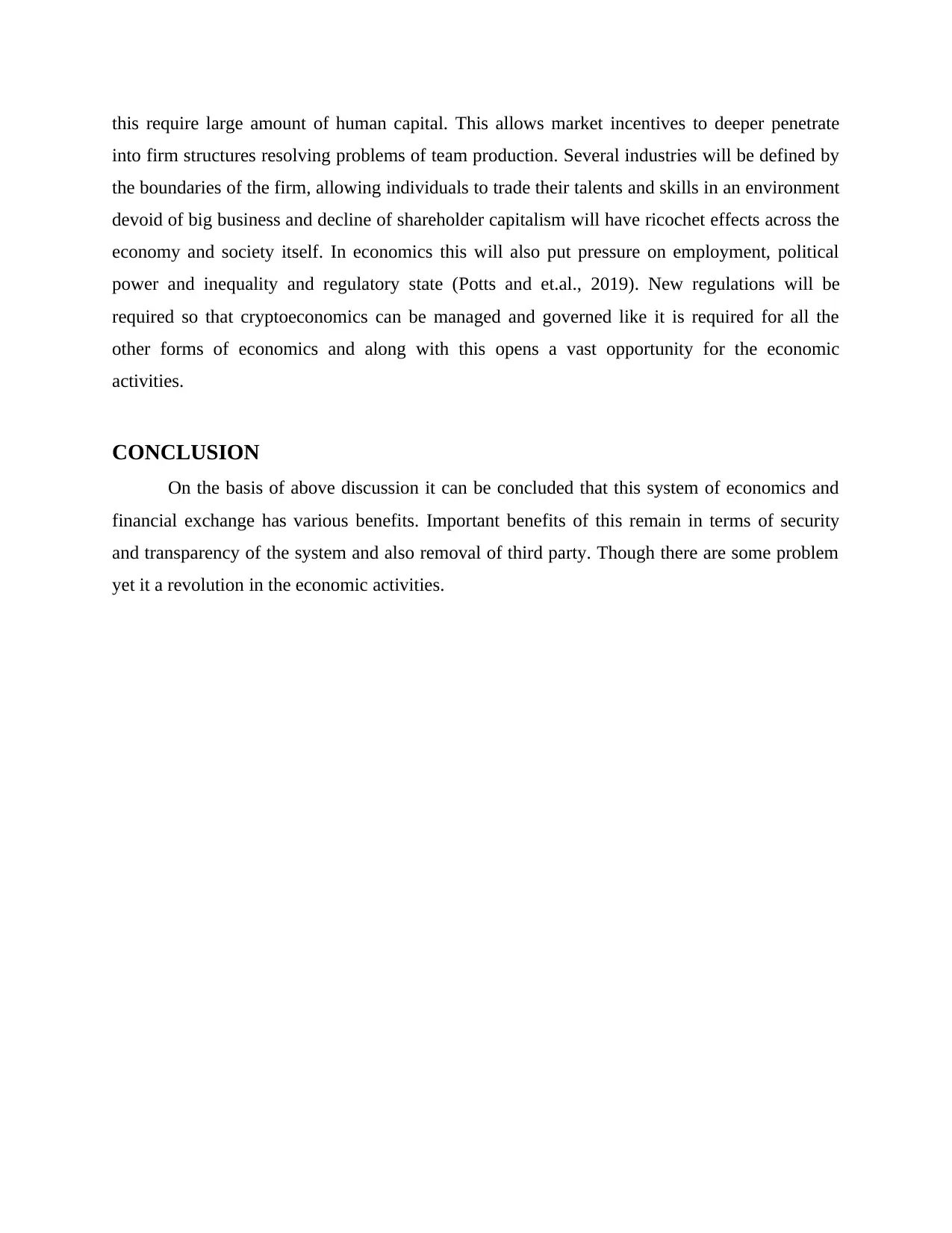
this require large amount of human capital. This allows market incentives to deeper penetrate
into firm structures resolving problems of team production. Several industries will be defined by
the boundaries of the firm, allowing individuals to trade their talents and skills in an environment
devoid of big business and decline of shareholder capitalism will have ricochet effects across the
economy and society itself. In economics this will also put pressure on employment, political
power and inequality and regulatory state (Potts and et.al., 2019). New regulations will be
required so that cryptoeconomics can be managed and governed like it is required for all the
other forms of economics and along with this opens a vast opportunity for the economic
activities.
CONCLUSION
On the basis of above discussion it can be concluded that this system of economics and
financial exchange has various benefits. Important benefits of this remain in terms of security
and transparency of the system and also removal of third party. Though there are some problem
yet it a revolution in the economic activities.
into firm structures resolving problems of team production. Several industries will be defined by
the boundaries of the firm, allowing individuals to trade their talents and skills in an environment
devoid of big business and decline of shareholder capitalism will have ricochet effects across the
economy and society itself. In economics this will also put pressure on employment, political
power and inequality and regulatory state (Potts and et.al., 2019). New regulations will be
required so that cryptoeconomics can be managed and governed like it is required for all the
other forms of economics and along with this opens a vast opportunity for the economic
activities.
CONCLUSION
On the basis of above discussion it can be concluded that this system of economics and
financial exchange has various benefits. Important benefits of this remain in terms of security
and transparency of the system and also removal of third party. Though there are some problem
yet it a revolution in the economic activities.
⊘ This is a preview!⊘
Do you want full access?
Subscribe today to unlock all pages.

Trusted by 1+ million students worldwide
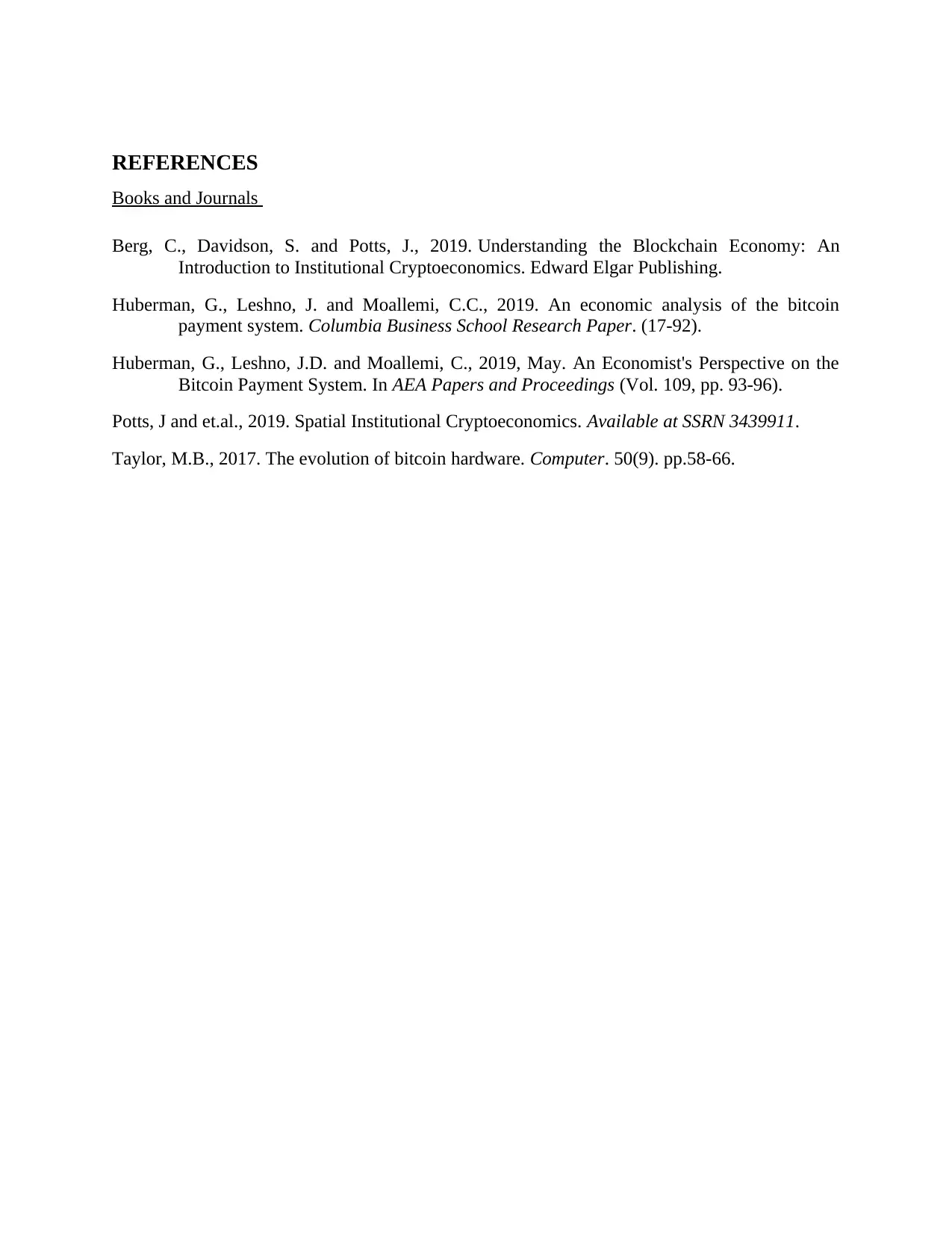
REFERENCES
Books and Journals
Berg, C., Davidson, S. and Potts, J., 2019. Understanding the Blockchain Economy: An
Introduction to Institutional Cryptoeconomics. Edward Elgar Publishing.
Huberman, G., Leshno, J. and Moallemi, C.C., 2019. An economic analysis of the bitcoin
payment system. Columbia Business School Research Paper. (17-92).
Huberman, G., Leshno, J.D. and Moallemi, C., 2019, May. An Economist's Perspective on the
Bitcoin Payment System. In AEA Papers and Proceedings (Vol. 109, pp. 93-96).
Potts, J and et.al., 2019. Spatial Institutional Cryptoeconomics. Available at SSRN 3439911.
Taylor, M.B., 2017. The evolution of bitcoin hardware. Computer. 50(9). pp.58-66.
Books and Journals
Berg, C., Davidson, S. and Potts, J., 2019. Understanding the Blockchain Economy: An
Introduction to Institutional Cryptoeconomics. Edward Elgar Publishing.
Huberman, G., Leshno, J. and Moallemi, C.C., 2019. An economic analysis of the bitcoin
payment system. Columbia Business School Research Paper. (17-92).
Huberman, G., Leshno, J.D. and Moallemi, C., 2019, May. An Economist's Perspective on the
Bitcoin Payment System. In AEA Papers and Proceedings (Vol. 109, pp. 93-96).
Potts, J and et.al., 2019. Spatial Institutional Cryptoeconomics. Available at SSRN 3439911.
Taylor, M.B., 2017. The evolution of bitcoin hardware. Computer. 50(9). pp.58-66.
1 out of 7
Related Documents
Your All-in-One AI-Powered Toolkit for Academic Success.
+13062052269
info@desklib.com
Available 24*7 on WhatsApp / Email
![[object Object]](/_next/static/media/star-bottom.7253800d.svg)
Unlock your academic potential
Copyright © 2020–2025 A2Z Services. All Rights Reserved. Developed and managed by ZUCOL.





